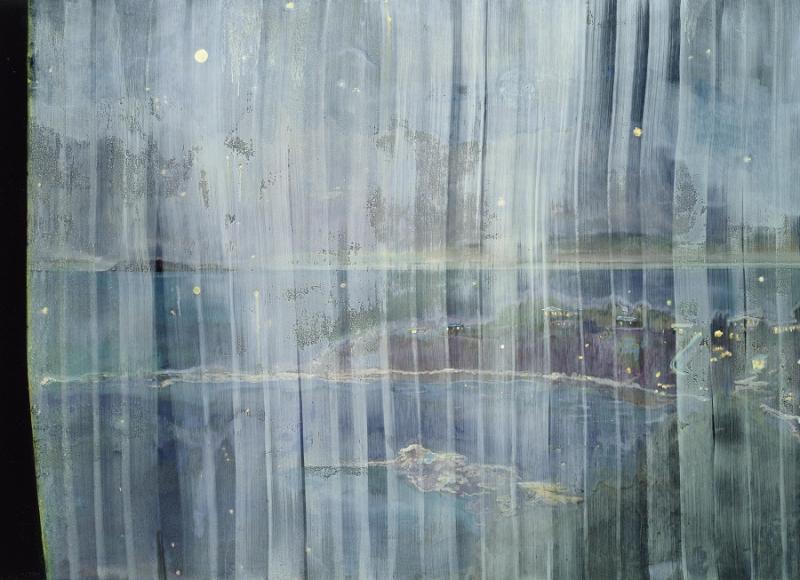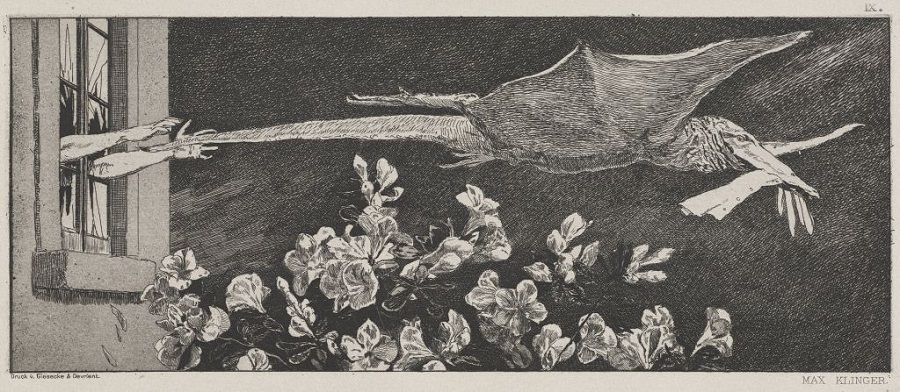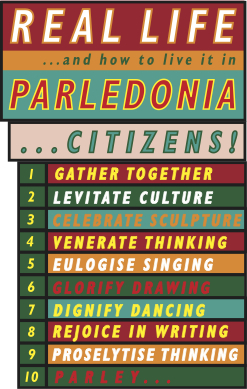theartsdesk at the Edinburgh Art Festival | reviews, news & interviews
theartsdesk at the Edinburgh Art Festival
theartsdesk at the Edinburgh Art Festival
Connection and debate are this year's festival themes, but the highlight is Peter Doig's mesmerising survey

The highlight of this year’s Edinburgh Art Festival is undoubtedly Peter Doig’s No Foreign Lands. As you enter the beautifully proportioned and wonderfully hung rooms of the Scottish National Gallery (until 3 November) the spirit of last year’s Festival exhibition of European Symbolist Landscape seems still to linger and has found its modern echo.
The rooms are flooded with colour and dramatic atmosphere. On large canvases the layers of colour appear to billow, bleed, swirl, drift and fade into one another, tonally quivering and shimmering. They awake spectral memories of other paintings from other times and other artists, and we are drawn to them as if we recognise the enigmatic figures in their various landscapes. Spectators stand to gaze at the pictures to try to see how the effect is achieved and whether, if they wait long enough, anything more will develop. One picture in particular attracts this long and patient gaze: Black Curtain (main picture).
Inspired by the magnificent Scottish landscape, it leaves you heady, breathless and refreshed
We look out of a window through a dreamy gauze at a nocturne of washed-out blues, greys, sea greens and stars, reminiscent of the subtle colour harmonies of Whistler. The overall effect is of a play or a film where the action is paused, a story stopped in mid-sentence. At the exhibition opening one question was put: what will the influence of this exhibition be on the generation of artists who come to see it? You can see for yourself the power of Doig's influence in the work of some of the artist's current crop of students at Doig Klasse: Düsseldorf – Edinburgh (the Canongate Venture until 1 September).
The work of an older Symbolist, the German Max Klinger, is the starting point for Peter Liversidge in Doppelgänger (Ingleby Gallery until 21 September). Playing with ideas of scale and how obsession can grow monstrously, the exhibition recreates the fevered claustrophobia of fin-de-siècle society first in the windowless panelled downstairs gallery and then upstairs where all the blinds are drawn. The careless action of a dropped glove generates an increasingly nightmarish series of etchings as the central image is transformed through the artist’s imagination. (Pictured below: Entfuhrung, courtesy of the artist and Ingleby Gallery)
 Liversidge intervenes to develop the image further and it falls out of Klinger’s framed world to become a series of ghostly marble-gloved hands on the gallery floor. The monochrome nature of the exhibition serves to heighten its surreal psychological effect and sears the image of the shape-shifting glove into the onlooker’s mind, making it almost impossible to shake off.
Liversidge intervenes to develop the image further and it falls out of Klinger’s framed world to become a series of ghostly marble-gloved hands on the gallery floor. The monochrome nature of the exhibition serves to heighten its surreal psychological effect and sears the image of the shape-shifting glove into the onlooker’s mind, making it almost impossible to shake off.
The festival not only acts as an umbrella drawing together the wide diversity of shows running throughout the City – some 50 in total – but also has its own ambitious programme of 10 publicly-sited commissions under the theme of Parley. With the Independence referendum set for October 2014, Parley invites us to consider how art can be an agent for debate and social change.
The commissions, dotted throughout Edinburgh, offer distinct ways of looking at what is wrong with, or missing from, today’s public debate. The Complaints Choir (169 Rose Street until 1 September) presents a series of short films from eight different world cities of citizen choirs formed with the sole aim of putting into song what most irks them. Issues of personal, local and global significance emerge, but the clearest message is that political elites everywhere are out of touch and any genuine sense of connection between government and the governed has been lost. Kenny Watson in Days similarly makes use of screaming headlines from the local Edinburgh Evening News as floor-to-ceiling wallpaper to illustrate not only local concerns writ large but how the press manipulates these concerns to sell newspapers. Can art do anything to re-engage and help modernise our democracy?
 Krijn de Koning offers us a space for discussion in his re-imagined agora: Land (ECA until 1 September). The Sculpture court at the Edinburgh College of Art with its classical plaster casts is transformed into a public square. The statues half wrapped emerge from protective wooden cases which create a seating, standing or meeting area. Ross Sinclair uses the paraphernalia of the PR world and our seemingly endless fascination with “top 10” formats to cover the city with colourful listed slogans in Real Life and How to Live it in Auld Reekie (pictured right). The lists are printed on posters, badges, beer mats and pamphlets (until 1 September). Rachel Maclean's I HEART SCOTLAND screenprints and her short film The Lion and the Unicorn (Edinburgh Printmakers until 7 September) presents a dark fairytale of the Independence debate as a gloriously baroque pantomime - Spitting Image meets Fantastic Mr Fox - using riotous costume and make-up. Alex Salmond, David Cameron and Jeremy Paxman should take note. It sparked a more genuine and lively debate at the viewing I attended than any stirred by Newsnight.
Krijn de Koning offers us a space for discussion in his re-imagined agora: Land (ECA until 1 September). The Sculpture court at the Edinburgh College of Art with its classical plaster casts is transformed into a public square. The statues half wrapped emerge from protective wooden cases which create a seating, standing or meeting area. Ross Sinclair uses the paraphernalia of the PR world and our seemingly endless fascination with “top 10” formats to cover the city with colourful listed slogans in Real Life and How to Live it in Auld Reekie (pictured right). The lists are printed on posters, badges, beer mats and pamphlets (until 1 September). Rachel Maclean's I HEART SCOTLAND screenprints and her short film The Lion and the Unicorn (Edinburgh Printmakers until 7 September) presents a dark fairytale of the Independence debate as a gloriously baroque pantomime - Spitting Image meets Fantastic Mr Fox - using riotous costume and make-up. Alex Salmond, David Cameron and Jeremy Paxman should take note. It sparked a more genuine and lively debate at the viewing I attended than any stirred by Newsnight.
Katri Walker’s commission An Equilibrium Not of this World (ECA until 1 September) is a short sound-and-visual meditation on running, physical endurance and our ties to the natural world. Inspired by the magnificent Scottish landscape, it leaves you heady, breathless and refreshed.
This necessity of connection with the natural world permeates Jupiter Artland, the inspiring sculpture park just outside Edinburgh whose meadows and woodland create a unique setting for wandering and exploring artworks, each of which is made in response to a specific location selected by the artist. In Sara Barker's Patterns (until 15 September) a painted metal sculpture within a glass structure reflects the ever-changing light and weather of the landscape providing a space for the onlooker to pause and think.
Here, Jeremy Deller and Alan Kane have built the Heath Robinson-like Steam Powered Internet Engine. In trying to create something that connects the industrial and digital revolutions they have perhaps hit upon what is missing from current public debate. As you walk across Ian Hamilton Finlay’s Only Connect bridge you begin to think maybe it's the gathering together, the shared links and associations and ideas.
In Follow the Thread – Fleece to Fibre – the Making of the Large Tree Tapestry (Dovecot Studios until 14 September) an extraordinary tapestry has been woven. It contains many stories – of the artist who created the template for the tapestry, of the shepherdess whose life it portrays, of the sheep whose wool made it, and of the weavers who wove the tapestry. These various narrative threads combine to reveal, with great artistry, how a society can work.
Austrian artist Franz West appears in Mostly West: Franz West and Artist Collaborations (Inverleith House until 22 September) and the exhibition might well have warmed to the Parley theme. West believed it didn't matter what art looked like but how it was used. Art, he declared, should be participatory. The works in this exhibition were made with fellow artists from 1982 to just before West's death in 2012. Yet despite being invited to touch, feel and play with some of the exhibits, the experience felt somehow empty. For today’s audience, perhaps his message has already been digested and superseded, the context having moved on.
Explore topics
Share this article
The future of Arts Journalism
You can stop theartsdesk.com closing!
We urgently need financing to survive. Our fundraising drive has thus far raised £49,000 but we need to reach £100,000 or we will be forced to close. Please contribute here: https://gofund.me/c3f6033d
And if you can forward this information to anyone who might assist, we’d be grateful.

Subscribe to theartsdesk.com
Thank you for continuing to read our work on theartsdesk.com. For unlimited access to every article in its entirety, including our archive of more than 15,000 pieces, we're asking for £5 per month or £40 per year. We feel it's a very good deal, and hope you do too.
To take a subscription now simply click here.
And if you're looking for that extra gift for a friend or family member, why not treat them to a theartsdesk.com gift subscription?
more Visual arts
 'We are bowled over!' Thank you for your messages of love and support
Much-appreciated words of commendation from readers and the cultural community
'We are bowled over!' Thank you for your messages of love and support
Much-appreciated words of commendation from readers and the cultural community
 Lee Miller, Tate Britain review - an extraordinary career that remains an enigma
Fashion photographer, artist or war reporter; will the real Lee Miller please step forward?
Lee Miller, Tate Britain review - an extraordinary career that remains an enigma
Fashion photographer, artist or war reporter; will the real Lee Miller please step forward?
 Kerry James Marshall: The Histories, Royal Academy review - a triumphant celebration of blackness
Room after room of glorious paintings
Kerry James Marshall: The Histories, Royal Academy review - a triumphant celebration of blackness
Room after room of glorious paintings
 Folkestone Triennial 2025 - landscape, seascape, art lovers' escape
Locally rooted festival brings home many but not all global concerns
Folkestone Triennial 2025 - landscape, seascape, art lovers' escape
Locally rooted festival brings home many but not all global concerns
 Sir Brian Clarke (1953-2025) - a personal tribute
Remembering an artist with a gift for the transcendent
Sir Brian Clarke (1953-2025) - a personal tribute
Remembering an artist with a gift for the transcendent
 Emily Kam Kngwarray, Tate Modern review - glimpses of another world
Pictures that are an affirmation of belonging
Emily Kam Kngwarray, Tate Modern review - glimpses of another world
Pictures that are an affirmation of belonging
 Kiefer / Van Gogh, Royal Academy review - a pairing of opposites
Small scale intensity meets large scale melodrama
Kiefer / Van Gogh, Royal Academy review - a pairing of opposites
Small scale intensity meets large scale melodrama
 Jenny Saville: The Anatomy of Painting, National Portrait Gallery review - a protégé losing her way
A brilliant painter in search of a worthwhile subject
Jenny Saville: The Anatomy of Painting, National Portrait Gallery review - a protégé losing her way
A brilliant painter in search of a worthwhile subject
 Abstract Erotic, Courtauld Gallery review - sculpture that is sensuous, funny and subversive
Testing the boundaries of good taste, and winning
Abstract Erotic, Courtauld Gallery review - sculpture that is sensuous, funny and subversive
Testing the boundaries of good taste, and winning
 Edward Burra, Tate Britain review - watercolour made mainstream
Social satire with a nasty bite
Edward Burra, Tate Britain review - watercolour made mainstream
Social satire with a nasty bite
 Ithell Colquhoun, Tate Britain review - revelations of a weird and wonderful world
Emanations from the unconscious
Ithell Colquhoun, Tate Britain review - revelations of a weird and wonderful world
Emanations from the unconscious
 Rachel Jones: Gated Canyons, Dulwich Picture Gallery review - teeth with a real bite
Mouths have never looked so good
Rachel Jones: Gated Canyons, Dulwich Picture Gallery review - teeth with a real bite
Mouths have never looked so good

Add comment